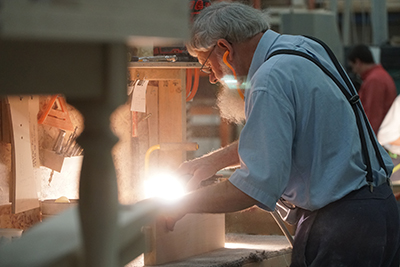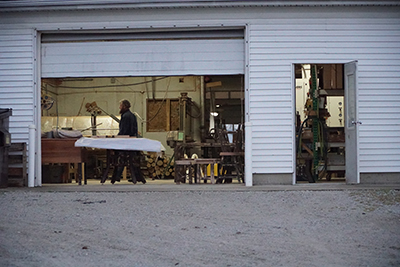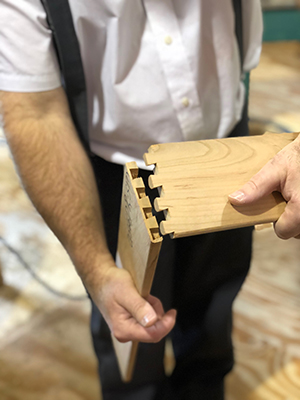Slow Furniture Movement
What is the Slow Furniture Movement?
The Slow Furniture Movement embraces the deliberate creation and use of durable furniture. A part of the Slow Movement that values quality over quickness, it has emerged as a response to the mass production of disposable “fast” furniture.
Too much furniture has become a “buy it cheap and throw it away” commodity, with little regard for the important place that furniture holds in creating a home that supports an authentic life. In the long run this is costing dearly, with furniture performing poorly due to inferior construction then breaking down to become waste that fills landfills and ultimately requiring the owner to spend more on replacement furniture.

At DutchCrafters, Amish furniture is built on the principles of strength, beauty and durability, and these principles reflect slow furniture at its very core. After reading books on slow food, our CEO Jim Miller saw the correlation and started talking about the value of slow furniture. We feel humbled to pioneer this important movement that reclaims the value of intentionally built, well-made furniture.
The Slow Furniture Movement recognizes the story that grows around the furniture you use in your home. The memories that are made and the monumental events that occur are unique to every family. We believe in building furniture that’s made with great purpose to work well, look beautiful and last throughout all of life’s moments.
You’re a part of the furniture we create. While you’re waiting for the ideal build, your needs, questions and input are put at the very top of the list, involving you in the selection of solid wood type, finish colors, features and custom additions that are sure to be enjoyed for many years to come.
5 Principles of the Slow Furniture Movement
- Supports investing in quality made, highly durable furniture.
- Recommends pieces of furniture that are multi-functional.
- Believes the time it takes to make good furniture is worth the wait.
- Supports furniture production that pays and treats workers fairly.
- Rejects fast furniture that’s mass produced and cheaply made.
Amish Furniture Lives in the Slow Furniture Movement
The DutchCrafters experience embraces the Slow Furniture Movement in every way. The opposite of a quick, cheap purchase of a mass-produced piece that looks like everyone else’s, our furniture embraces traditional, time-honored techniques that Amish craftsmen have been practicing and perfecting for decades. It connects everyone involved to the design and building of new furniture, creating a connection between customer vision and quality living.
The person who will own the furniture is an integral part of the furniture building process. There’s the excitement of viewing wood samples with different finish colors, the selection of features like hardware and drawer slides, the discussion about dimensions that will work best in your space and the highly anticipated delivery day, when your new furniture arrives, carefully blanket wrapped to protect the solid wood that will reveal the quality you’ve invested in, with limited packaging waste that needs to be thrown out.
Slow furniture brings a story with it, a story that can be shared with family and can easily begin with, “I had this made in an Amish woodshop,” or, “I scoured thrift shops until I found this piece to complete my vision.” With slow furniture, the story goes on to include “I inherited this solid wood table from my mother, and it’s just as beautiful as when I used it as a child.”
Within the slow furniture movement, it’s not about looking for the lowest price tag or quickest delivery. There are satisfaction and pride in investing in furniture that’s harder to make, that takes longer to make and feels great to own.
Slow Food, Slow Fashion and Slow Furniture
Slow furniture is part of a broader slow movement that includes slow food and slow fashion, investing in the product, the process and the person to receive it, whether that be the joyous creation of a hearty meal, the sparkle and divine fit of an evening gown, or the cutting, creating, finishing and delivery of a piece of solid wood furniture.
The slow movement is about creating things to the best of one’s ability, savoring the process, and honoring the time to do quality work with an awareness of the long-term effects.
One example of slow fashion is the design team Eugene Alexander, whose 1980s and ’90s couture gowns are still worn today. At DutchCrafters, we saw the connection between our furniture process and their story and were honored with the opportunity to produce a documentary about them.
Slow Furniture vs. Fast Furniture
Fast furniture may be cheap and arrive quickly, but unfortunately that’s not the only thing that’s quick about it. It’s quick to break, wear out, get thrown out and leave you out the money you spent for it in the first place. Here are some contrasts between fast and slow furniture.
| Fast Furniture | Slow Furniture |
| Efficient manufacturing | Time-honored craftsmanship |
| Sourced globally | Built locally or regionally |
| Veneers | Solid wood, metal, glass |
| Low-wage workers | Family-owned shops |
| Cheap in the short run | Cost-effective over time |
| Ends up in the landfill | Passed on to the next generation |
| Quick, off the shelf | Built for you |
| Delivered quickly | Worth the wait |
| Impulse buy – quick and easy | Intentional – customer makes decisions |
| Made with chemicals and compounds | Made with traditional materials |
| Artificial grain | Grain from a real tree |
| Limited options | Personalized |
| Forgettable | Something friends will admire |
| Consumed | Appreciated, savored |
Why Join the Slow Furniture Movement?

There are many reasons to invest in slow furniture, including getting a better value and encouraging sustainable practices. It is also admirable to support small businesses and family-owned woodworking shops. But more important, it is about your family and your home. It is the opportunity to be a part of the creation of the furniture that you will use every day, selecting the wood type, finish, hardware and options that will add to the beauty and function of your home. It is not just saving an antique piece of furniture from the landfill but bringing it back to its original charm by refinishing old furniture. It is honoring the kind of furniture that can be passed on for generations and the satisfaction in owning furniture that performs at that level. It is the joy in loving what surrounds you every day.
Ways to Participate in the Slow Furniture Movement

- Buy furniture made with durable, quality materials. The goal is for it to last long and be passed on, without needing to be replaced.
- Select furniture that allows you to customize to fit you and your family’s lifestyle.
- Be more thoughtful about what your furniture is intended for. Invest in items that are used the most in rooms the family uses the most. Remember buying quality furniture means you are going to have it for a long time, so be more thoughtful about the design, colors, use, etc.
- Select multi-functional furniture that offers you the most for the money.
- Look for handcrafted furniture. Handcrafted ensures time, effort and thought went into the furniture.
- Shop furniture from small businesses and local woodworkers.
- Avoid mass-produced “fast furniture.”
- Shop furniture made with sustainable practices, renewable resources, and recycled materials.
- Shop solid wood or other high quality secondhand or pre-owned furniture from online marketplaces, thrift stores, and consignment shops.
- When buying used furniture (from thrift stores, estate sales, etc.) take your time and make sure it’s safe (i.e. no damage to wood, still functions well, etc.).
- Utilize do-it-yourself methods to create or repurpose furniture for your home or business.
Here at DutchCrafters, Amish furniture is the epitome of well made, multi-functional, high value and environmentally aware furniture. It’s a natural fit to represent the principles of the Slow Furniture Movement that embraces better furniture for you, your community and the world.
Won’t you join us?

